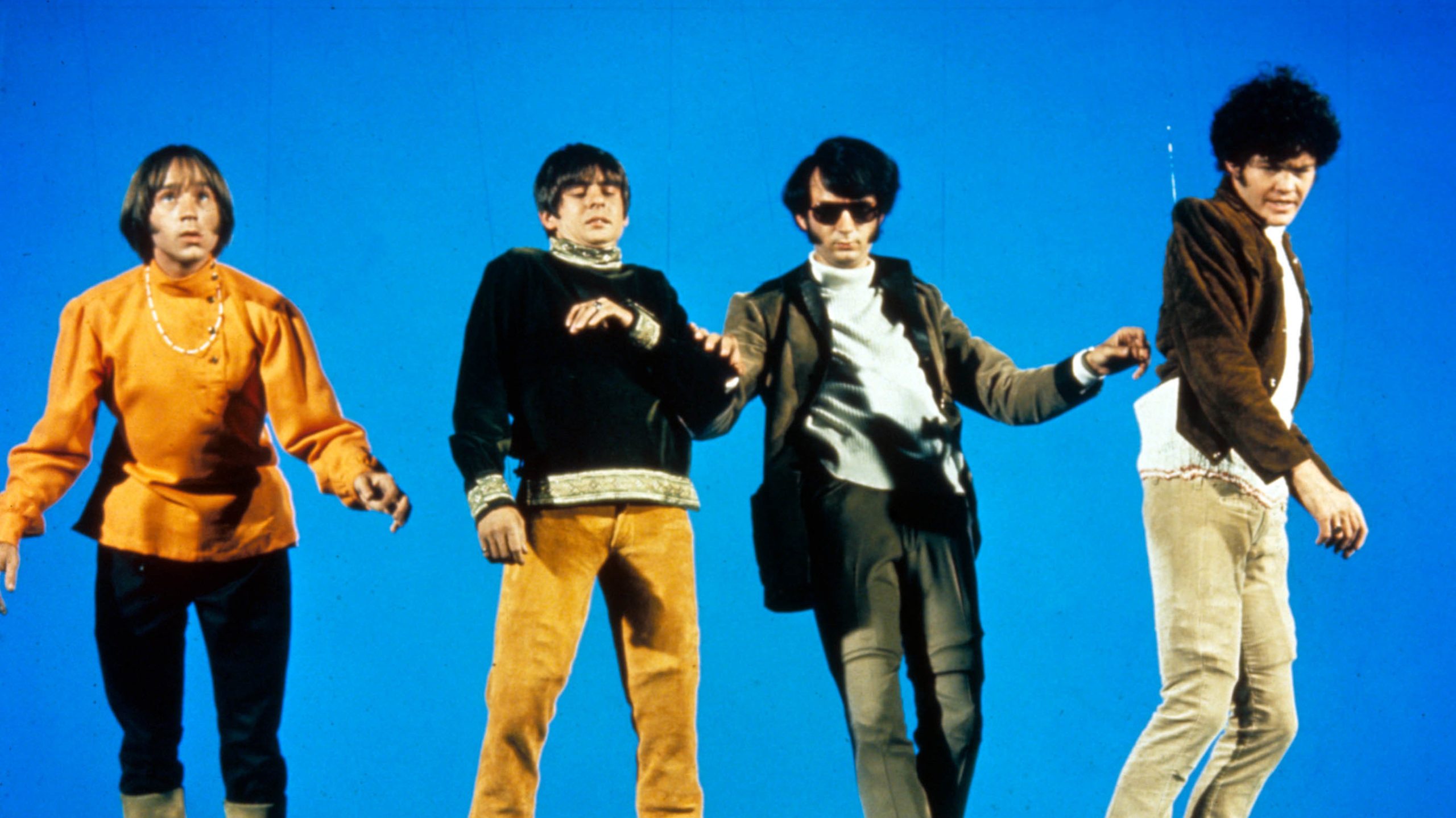Timeline: 1968 - 'Head' - Career Suicide By Way Of Abstract Pop Art Cinema - We Look Back On The Monkees Film, 55 Years On

By Dave Swanson - Summit FM Contributor
In the fall of 1966, something happened. A television program appeared on NBC, that would defy all odds and ultimately deny all naysayers, 'The Monkees' premiered on Monday, September 12, to a waiting world. Inspired by the ongoing sensation known as The Beatles, this was a TV show about an aspiring rock and roll band, four young men trying to make it in show business, but never succeeding, in the series at least. Reality proved a very different animal, as the fictional band became a real band with real hits, big hits, and sold out concerts.
"It was like Leonard Nimoy actually becoming a Vulcan," Micky Dolenz often said of the Monkees, the band he handled most of the lead vocals for as well as playing the role of their drummer. All members of the band did have some musical background, but they were hired to play roles, not to be musicians. That is until guitarist Michael Nesmith threatened producer Don Kirshner, famed behind the scenes creative force and music supervisor of the show. After punching a hole in the wall and claiming, "that could have been your face," to Kirshner, Nesmith walked out with the show's producers and other band members fully behind him.
What this meant was that not only did The Monkees begin to have creative control over their music, writing their own songs, playing on and producing the records, but by the second season of the show, the wheels had truly come off the wagon. Gone was the laugh track, something no ‘sitcom’ lived without at the time, also gone for the most part, were the cliché story lines. Instead, that second season started including references to current events including drugs, hippies, war, violence not to mention being one of the first television shows to 'break the fourth wall' and periodically reference the fact that this was a television show, going as far as stating "you see one episode, you've seen them all" in "Monkees Go To Paris' which had no other dialog as it simply showed the guys roaming around Paris.
The final episodes of the series, in the spring of 1968, included guests like Frank Zappa and folk singer Tim Buckley, at the request of the band members. At the end of the second season of the show, in the spring of 1968, the plug was pulled, the Pre-Fab Four had outstayed their welcome. Once the show was off the air, the records stopped selling, 'Valeri' being their last stop in the Top 10 in February of 1968. The band had been in talks to make a full length feature film, and now that the show had ceased, they had time to do so.
The forces behind 'Head' were two of the guys behind the television show, Bert Schneider and Bob Rafelson, who had begun working with a new friend, a struggling actor named Jack Nicholson. This team, along with input from all four Monkees, Dolenz, Jones, Nesmith, and Tork, would create a cinematic adventure unlike any other. It was, in so many ways, a suicide note left by the band, but instead of taking their own lives, they were sacrificing their career. Poking holes in the facade many critics, hippies and the like, had long criticized The Monkees as being. Honestly, it has only been in the last couple decades where people began to 'forgive' the 'pre-fab four' for merely being, and trying to make a living.
I could go on how, in more ways than one, the Monkees (the band and the show) were among the most subversive entities of the 1960s, as they brought the counterculture its music, clothes, attitude, politics, and lifestyle, or at least references to, right into living rooms across the world. 'Head' would take that spirit and let it run wild. The film essentially begins with all four Monkees jumping off a high level bridge into the ocean below, thus committing suicide of the 'manufactured' pop group. "You say we're manufactured, on that we all agree, so make your choice and we'll rejoice in never being free," they sing in the montage scene known as 'Ditty Diego/War Chant' which leads into the next scene where they are in combat scene where you hear the soldier, who is wearing a football uniform, kick the dirt and say "let's get this game over with," a not so subtle reference to the Vietnam War. And if that didn't drive the point home, using the infamous footage of General Nguyen Ngoc Loan's summary execution of a Viet Cong prisoner on a Saigon street, mixed in with live concert footage of the band performing, couldn’t be any more obvious. The foursome tear apart seemingly every aspect of the pop culture bubble they lived in, and at times, works as an almost stream of consciousness style of film presentation, as one scene stumbles into the next with no real connection, at least not at first.
"I'd been writing and Rafelson and I were talking, and I said, 'Bob I can write a movie about anything," recalled Jack Nicholson in a 2010 interview. "And he said 'can you write a movie for the Monkees?' And I said 'The Monkees? You gotta be kidding me,' cause I didn't really know them, all I knew was it was a successful television show about a rock and roll group. So I went home that night and thought up two movies and I go into Bert (Schneider), and I didn't know Bert or how cool he was, and I go well, I got two movies for you. One of 'em I can guarantee you will be as big a hit as ‘A Hard Day's Night,’ and with equal certainty, the other one I can guarantee you won't make a nickel and he says, 'I want the second one!'"
The cast is long and odd, including Victor Mature, Dennis Hopper, Annette Funicello, Frank Zappa, Sonny Liston, Terri Garr, and Toni Basil, to name a few. Aside from picking themselves apart, they take digs at the counter culture itself throughout. True satire set in a hallucinogenic haze. "It made no more sense to me than it ever had," recalled Funnicello about seeing the final product in a 1994 interview. "But it was a challenging, offbeat role, and I was happy to play it." The title of the film only appears on screen as the film credits roll at the end. It was an inside joke among the film makers thinking their next film could be promoted as, "from the people who gave you ‘Head.’" The fact that all this was happening in a film starring a band whose fans were primarily between the ages of 7 and 13 makes it even more bizarre. "Jack and I wrote ‘Head’ in strange places, closets and basements," said Bob Rafelson, "Sometimes under the influence of Timothy Leary's little pills."
The film opened in New York then spread with little fanfare. A box office giant it was not. In more recent years many a critic has had a reappraisal of the movie, what it meant and how it fit in with the coming Hollywood renaissance. It is no small coincidence that the trio behind this movie would go on the following year to make 'Easy Rider,' one of the most significant films of the counterculture, as the1960s gave way to the 1970s. Both Rafelson and Schneider stated over the years that without 'Head,' there would have been no 'Easy Rider.' The Monkees, no surprise, were left in the dust, though of course, over time many have made their peace with the whole of 'The Monkees,’ including the band members themselves, most notably Michael Nesmith who was the last holdout, never fully appreciating the impact they had on people, until shortly before he died in 2022. Do not view the film and try to make sense of it. It truly is a Pop Art meets Pop culture exercise in surrealism which was, of course, very heady stuff for a band considered the Bubblegum Pariah of the music industry. "There's something about ‘Head,’" added Dolenz, "something about the sensibility, and the way Bob and Jack captured the spirit of the moment on film."
Though Monkees records continued to be released as they were still under contract to Colgems/RCA Records, with the series off the air, sales evaporated. Many stores that were selling box loads just a year prior weren't even stocking their new releases. Their contract had allowed for one final television special. ’33 & 1/3rd Revolutions Per Monkee’ finally aired in April of 1969, following the flop of ‘Head.’ Hipsters, music critics, and the like, really had no idea what the Monkees were truly about.
Fellow musicians, however, were much more forgiving, and the Monkees were tight with such legends as Stephen Stills, David Crosby, Mama Cass, Jimi Hendrix, Harry Nilsson, the Beatles, and many others. The soundtrack itself includes some of the most wonderful music ever released under the Monkees name. Along with the band, it features contributions from Neil Young, Carole King, Ry Cooder, Stephen Stills, and Jack Nitzche, among others. If the main theme of the film, 'The Porpoise Song', is not among the most beautiful records ever made, then I know nothing about music. Obviously The Beatles are at the center of most all pop music made in the last 60 years, but in my world, it’s always been about the Monkees, and always will be.
Just for the record here, I was (still am) obsessed with the Monkees. I had read about this movie in the works, in the pages of 16 Magazine, but by the time of release in fall of '68, their records weren't on the charts, and my local record store wasn't stocking it. So, at age 6, I placed my first special order for an LP! When it arrived, complete with silver mirror like sleeve, I was thrilled. Upon seeing the film, though unable to fully understand most of what was going on, it only added to my love of the band. The Monkees have never left me, and I wouldn't be who I am if not for them. They made me want to become a musician, to write songs, to explore music at every turn, and, to have fun! They are still a huge part of my existence.






